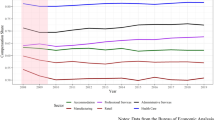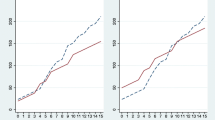Abstract
This paper examines whether bonus compensation for managers and workers matter for manufacturing plant productivity. We use a model based on a Cobb-Douglas production function where bonus incentives can increase worker effort and attract more skilled workers leading to increases in plant productivity. The effect of bonus compensation policies on productivity is estimated by using a representative sample of Indian manufacturing plants between 1999 and 2006. We find that conditional on a plant’s observable and unobservable characteristics, allocating a higher proportion of compensation to bonus pay for managers and workers has a significant positive effect on productivity.
Similar content being viewed by others
Notes
Standard errors for 200 bootstrap simulations were initially computed for the first set of regressions, but were found to be similar in magnitude to using only 100 bootstrap simulations.
GMM estimation is performed using STATA’s xtabond2 as described by Roodman (2009). This function is used as opposed to xtdpd because it allows for incorporation of sampling weights in the estimation process.
The census component covers 100 % of all units employing 100 or more people for all the ASI periods covered in the study. The census survey also applies to smaller states in the ASI where there is limited industrialization so as to more completely capture manufacturing activities in these areas. The sample component of the ASI represents formally registered manufacturing firm establishments employing 20–99 workers within a state at the four digit level of the National Industrial Classification (NIC) code when using sample weights with at least 20 % coverage of all manufacturing units and a minimum of six sample units.
For more detailed information on the ASI panel see Government of India (2011).
Industries include: food products, beverages/tobacco, textiles, textile products, wood products, paper products, leather products, basic chemicals, rubber/plastic/petroleum/coal, non-metallic products, metals and alloys, metal products, machinery and electrical, transport, and other manufacturing. The HHI was checked for these broad categories and the highest HHI was 0.09 in these broad categories in the cross-sectional data. The HHI for three digit industrial classification codes in the cross-sectional data was also checked. Less than 7 % of the industry-years had HHI’s >0.25 indicating that a majority of the plants are in fairly competitive industries.
This situation arises, for example, when two plants pay their workers the same baseline salary and bonuses of up to 20 % of the salary depending on a plant’s performance at the end of the year. It is possible that one plant may perform well and pay bonuses amounting to 20 % of the baseline salary, while the other performs poorly due to idiosyncratic shocks and pays no bonuses. In this case, we may wrongly conclude that a well-performing plant has a better incentive scheme using observed the ex-post share of bonus compensation out of total compensation even though both plants have the same incentive scheme.
References
Abowd JM (1990) Does performance-based managerial compensation affect corporate performance? Ind Lab Relat Rev 43(3)S: 52S–73S
Arellano M, Bond S (1991) Some tests of specification for panel data: Monte Carlo evidence and an application to employment equations. Rev Econ Stud 58:277–297
Arellano M, Bover O (1995) Another look at the instrumental variable estimation of error-components models. J Econom 68:29–51
Bandiera O, Barankay I, Rasul I (2007) Incentives for managers and inequality among workers: evidence from a firm-level experiment. Q J Econ 76(1):93–113
Bartel A, Ichniowski C, Shaw K (2007) How does information technology affect productivity? Plant-level comparisons of product innovation, process improvement, and worker skills. Q J Econ 122(4):1721–1758
Besley T, McLaren J (1993) Taxes and bribery: the role of wage incentives. Econ J 103:119–141
Black S, Lynch L (2001) How to compete: the impact of workplace practices and information technology on productivity. Rev Econ Stat 83(3):434–445
Black S, Lynch L (2004) What’s driving the new economy? The benefits of workplace innovation. Econ J 114(493):F97–F116
Bloom N, Van Reenen J (2006) Management practices, work-life balance, and productivity: a review of some recent evidence. Oxford Rev Econ Policy 22(4):457–482
Bloom N, Van Reenen J (2007) Measuring and explaining management practices across firms and nations. Q J Econ 122(4):1351–1408
Bloom N, Van Reenen J (2010) Chpt. 19: human resource management and productivity. In: Ashenfelter O, Card D (eds) Handbook of labor economics, vol 4b, 1st edn. North Holland, Elsevier, pp 1697–1768
Bloom N, Mahajan A, McKenzie D, Robert J (2010) Why do firms in developing countries have low productivity? Am Econ Rev Pap Proc 100(2):619–623
Bloom N, Genakos C, Sadun R, Van Reenan J (2012) Management across firms and countries. Acad Manag Perspect 26(1):12–33
Bloom N, Eifert B, Mahajan A, McKenzie D, Robert J (2013) Does management matter? Evidence from India. Q J Econ 128(1):1–51
Blundell R, Bond S (2000) GMM estimation with persistent panel data: an application to production functions. Econ Rev 19(3):321–340
Bollard A, Klenow P, Sharma G (2013) India’s mysterious manufacturing miracle. Rev Econ Dyn 16:59–85
Bruhn M, Karlan D, Schoar A (2010) What capital is missing in developing countries. Am Econ Rev Pap Proc 100:629–633
Bruhn M, Karlan D, Schoar A (2013) The impact of consulting services on small and medium enterprises: evidence from a randomized trial in Mexico. World Bank Economic Policy Research Paper No. 6508, Washington DC
Bryson A, Freeman R (2008) How does shared capitalism affect economic performance in the UK? In: Blasi J, Kruse D, Freeman R (eds) Shared capitalism at work: employee ownership, profit and gain sharing, and broad-based stock options. University of Chicago Press, Chicago, pp 201–224
Cappelli P, Neumark D (2001) Do “high-performance work practices improve establishment-level outcomes? Ind Labor Relat Rev 54(4):737–775
Chatzmichael K, Tzouvelekas V (2013) Human capital contributions to explain productivity differences. J Prod Anal. link.springer.com/article/10.1007%2Fs11123-013-0355-x
Chung D, Steenburgh T, Sudhir K (2013) Do bonuses enhance sales productivity? A dynamic structural analysis of bonus-based compensation plans. Market Sci 13(2):165–187
Eichengreen B, Gupta P (2011) The services sector as India’s road to economic growth. NBER Working Paper 16757, National Bureau of Economic Research
Government of India (2011) Time-series data on annual survey of industries (1998–1999 to 2007–2008). Central Statistics Office, Ministry of Statistics and Programme Implementation, Kolkota
Imbs J, Wacziarg R (2003) Stages of diversification. Am Econ Rev 93(1):63–86
Lazear E (2000) Performance pay and productivity. Am Econ Rev 90(5):1346–1361
Lazear E, Oyer P (2010) Personnel economics. In: Gibbons E, Roberts DJ (eds) Handbook of organizational economics. Elsevier, North Holland, Amsterdam (forthcoming)
Leonard JS (1990) Executive pay and firm performance. Ind Labor Relat Rev 43(3):11s–29s
Lin C, Shen W, Su D (2011) Executive pay at publicly listed firms in China. Econ Dev Cult Change 59(2):417–436
Moretti E, Perloff J (2002) Efficiency wages, deferred payments and direct incentives in agriculture. Am J Agric Econ 84(4):1144–1155
Nataraj S (2011) The impact of trade liberalization on productivity: evidence from India’s formal and informal manufacturing sectors. J Int Econ 85:293–301
Rodrik D (2013) Unconditional convergence in manufacturing. Q J Econ 128(1):165–204
Roodman D (2009) How to do xtabond2: an introduction to “difference” and “system” GMM in STATA. STATA J 9(1):86–136
Shapiro K, Stiglitz J (1984) Equilibrium unemployment as a worker discipline device. Am Econ Rev 74(3):433–444
Syverson C (2011) What determines productivity? J Econ Lit 49(2):326–365
Topalova P, Khandelwal A (2011) Trade liberalization and firm productivity: the case of India. Rev Econ Stat 93(3):995–1009
Tybout JR (2000) Manufacturing firms in developing countries: How well do they do, and why? J Econ Lit 38(1):11–44
Young A (2003) Gold into base metals: productivity growth in the People’s Republic of China during the reform period. J Polit Econ 111(6):1220–1261
Acknowledgements
Detailed feedback from Aashish Mehta and two anonymous referees has been integral to the reformulation of this paper. Research assistance by Glenita Amoranto was helpful in the early stages of the development of this paper.
Author information
Authors and Affiliations
Corresponding author
Rights and permissions
About this article
Cite this article
Chun, N., Lee, S. Bonus compensation and productivity: evidence from Indian manufacturing plant-level data. J Prod Anal 43, 47–58 (2015). https://doi.org/10.1007/s11123-014-0421-z
Published:
Issue Date:
DOI: https://doi.org/10.1007/s11123-014-0421-z




